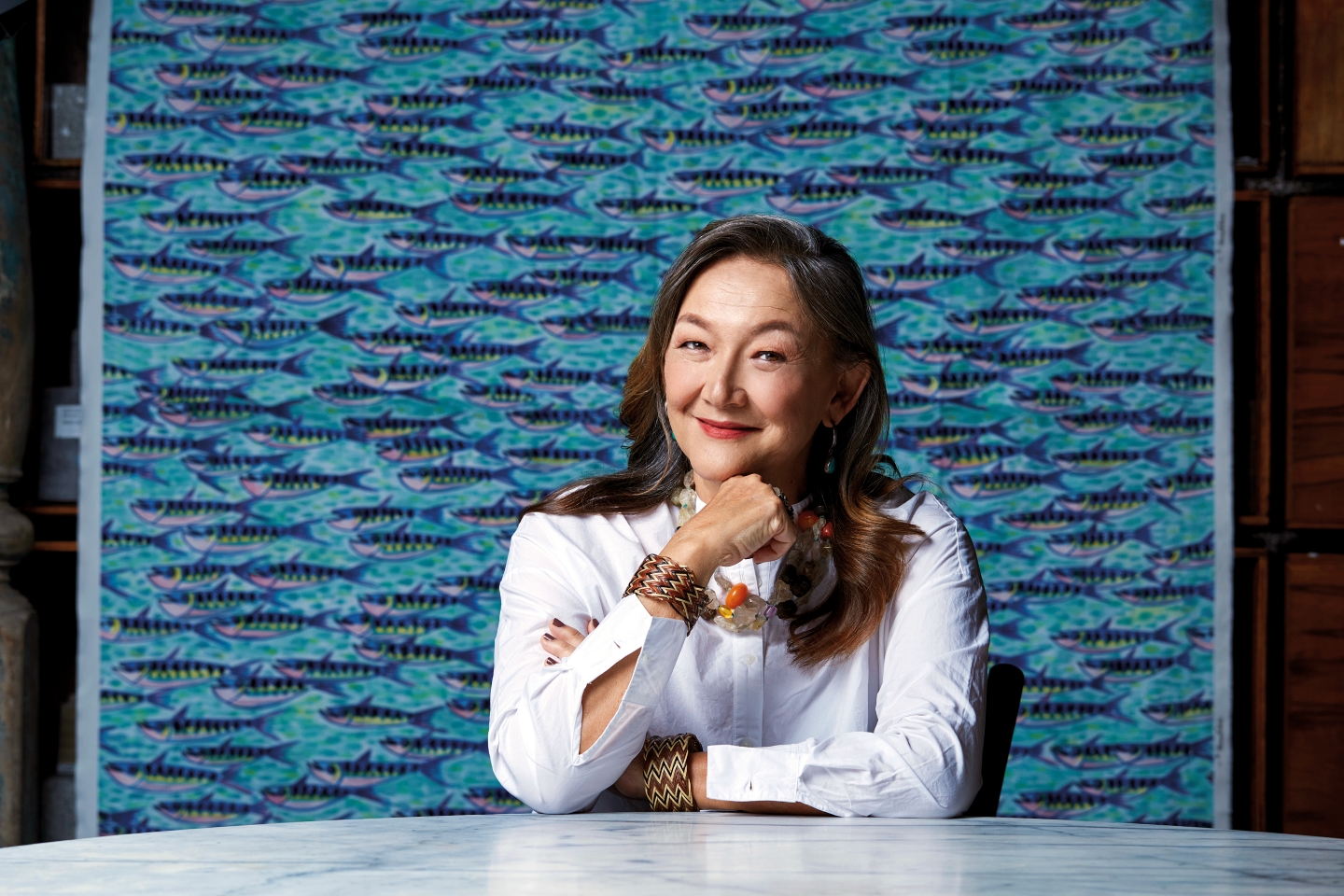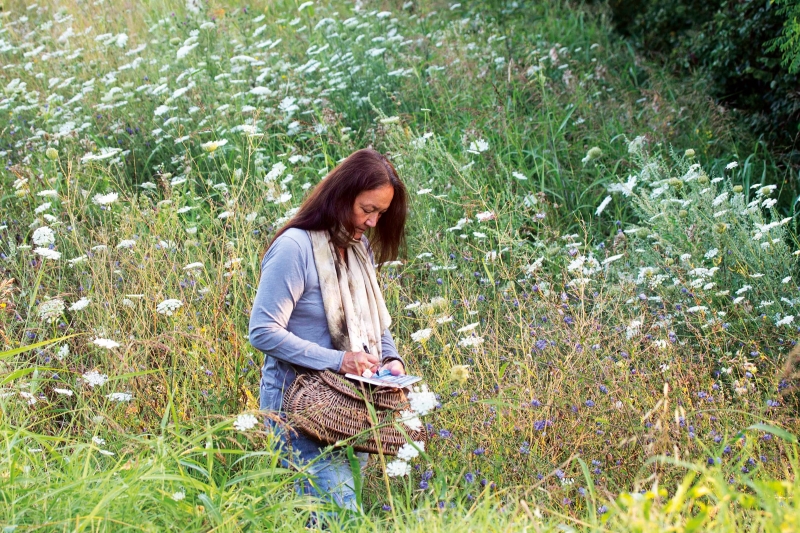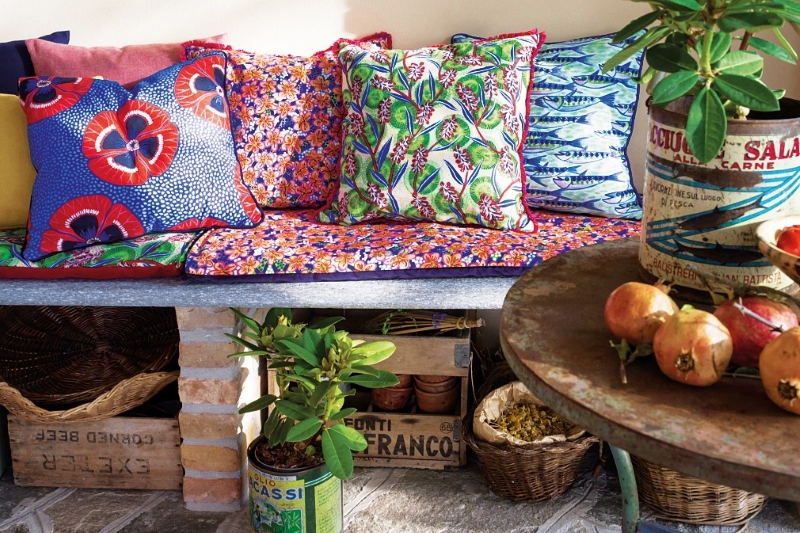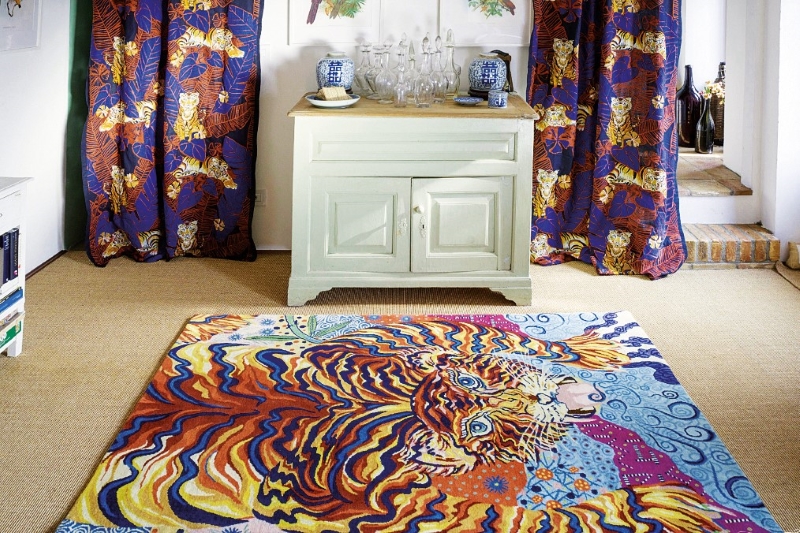
Rebecca graduated in woven and printed textiles from Parsons School of Design, New York (Photo: SooPhye)
Rebecca Duckett-Wilkinson’s Covid-19 experience was not unlike that of many others. But a happy quirk of fate, circumstance and reconnection with long-time friends led to a creative opportunity that was as unexpected as the virus that caused her to be stuck in Italy for two years.
“We have a house in Piedmont [in the northwest bordering France and Switzerland] and we’d go there for a month, usually in the spring or autumn. I arrived on March 2, 2020. Six days later, Italy, which was struck hard, locked down.”
Feeling isolated and alone — Rebecca’s husband David Wilkinson was then in Malaysia and their three grown children were spread around the world — the weaver and textile-print designer sought comfort in nature. “I was lucky to be in the countryside. It was remote, beautiful and there were not that many people.”
To keep herself positive, for want of a better adjective, through the “very hard and really sad time” in the country, she would go for long walks in the woods with friends. To pass time, she decided to begin working on her portfolio for a licensing fair for surface designers in New York that she hoped to join in 2021.
“Because I needed to focus, I set a target of painting one pattern a day. I began with A4-size paper and moved on to bigger sheets. I started on March 22 and kept on going. It became slightly obsessive. Before I knew it, I ended up with 100 patterns in 100 days.”
There was no shortage of ideas on what to paint for this Malaysian who learnt, from young, to draw insects and fish on the plantations where her father worked. When Italy’s Covid-19 situation worsened and movement was restricted to 250m outside of the home, Rebecca began to look “properly” around her at wildflowers, grass seeds and things one would normally just walk past. “Everything had remained wild as no one was working. The different types of weeds that came up were staggering.”
rebecca_duckett-wilkinson.jpg

Part of the fun of her daily routine was posting her paintings on Instagram. Two owners of the bar in her village up the hill who were talking about forming a local art community took notice and suggested that Rebecca put her works on their premises so everyone could see them. She ended up doing a little exhibition.
Then a couple whom she knew very well from when they were living in Kuala Lumpur 30 years ago called to say they would be driving down from Switzerland to Genoa. Could they stop by and spend a night with her?
Michael and Camilla Fischbacher arrived, dropped by the exhibition and started talking in Swiss-German, which “I did not understand. Then they said, ‘Look, Rebecca, it’s time we do a capsule collection’.”
In a nutshell, that was the genesis of Swiss luxury furnishing brand Christian Fischbacher’s collaboration with Rebecca on a collection that translated a selection of her patterns into fabrics. The family-run company founded in 1819 and based in St Gallen is a global provider of the finest interior fabrics, rugs, wallpaper, bed linen and accessories for homes, the contract sector and public spaces. Michael, the sixth generation, became CEO in 2008, and his wife Camilla is the creative director.
my textile prints onto fabrics and items known for their beautiful quality,” she says.
“Of course I knew [my friends] always had a family business, but basically, it specialised in luxury furnishing fabrics. Their style is completely different from mine and as Mickey always said, even when he
The 100 Patterns in 100 Days range, named after how Rebecca’s series of paintings came about, is threaded with its Italian story. “I was very excited at the thought of working with the brand and getting was in KL, ‘I love your work but there’s no way the company [can use you]. You’re just too colourful … it doesn’t suit their style. It’s such a shame.’
“I never thought anything about this because at that time we were doing Owen Rebecca Designs and it was all going strong.”
This is the first time the company is using a Malaysian designer and she is thrilled. “Yes, we had that connection. But, you know, it was the whole cycle. It’s taken that long for the idea [of having something that suits Christian Fischbacher] to come to fruition.”
cushions_3.jpg

All through the lockdown, she worked on turning her designs into repeats for the fabrics. In January this year, the collection was launched at the Paris Déco Off, dubbed the “fashion week of the interiors industry”, and is now working its way into the company’s showrooms.
Three patterns for the range, Poppy, Blossom and Pink Weed, are from the lot of 100 paintings. Ikan is based on a piece Camilla picked out when they visited. “She saw it and said she wanted to use it.” Curtain and upholstery fabrics featuring these patterns are available, as are cushions.
Two tigers on Dawon decorative cushions are from different paintings done earlier of the creature. The embroidered outlines of the design are combined with hand crewelwork, a centuries-old technique from Kashmir, India. Rebecca also did an original work called Harimau, depicting the Malayan tiger among stylised bamboo leaves and flowers. A carpet of that pattern is made from New Zealand wool tied in a Tibetan knot at a density of 100 Kpi (knots per square inch). It is available in three colourways and four sizes.
All the prints were translated exactly as her paintings and the shoot for a Christian Fischbacher lookbook was done at her house in Italy. The 100% medium-weight cotton drill used is very practical and one of the brand’s cheaper lines. “I’m really happy with that because it means the collection is more affordable. When you get close, you can see all the details and colours.” Her work is about layers and cross-hatching, with different hues painted in intersecting lines, giving rhythm to each piece, she explains.
“It took them a long time to decide which patterns they felt suited them. Yes, to a certain extent, I was surprised by what they chose. But now that I see them as fabrics, I really like them. They chose not necessarily anything that was matching — the designs went with a range.”
Having seen cushions with her prints placed alongside sofas and upholstered chairs, Rebecca has one word for the end result: “Brilliant!” She had reason to be proud: 100 Patterns in 100 Days won the Livingetc Style Award 2023 (UK) for best fabric collection on July 6.
Christian Fischbacher has not approached her for more designs, and Rebecca is realistic. “This is just something that kind of pops out from their main collection, like they do with other designers. The company can experiment and play and come up with something totally different from what they normally do.
tigers_2.jpg

“It was really interesting at the Paris launch because everyone was coming in and saying, ‘Colour! Yay!’ Because the brand is [about] hotels and big projects, things are normally quite subdued to fit in with the other furnishings and stuff. When the fabric samples were lined up, there was this little line of colour right in the middle where my prints were. It was really fun.”
Rebecca, 61 in November, graduated in woven and printed textiles from Parsons School of Design, New York. When the Central Market in KL transformed from being a wet market into a centre for Malaysian culture, heritage, art and craft and reopened in 1986, she was there with Owen Rebecca Designs. People flocked in for her trademark T-shirts and resort wear, attractive for their strong colours and floral prints that many still talk about, and wear, today.
Natural history and botany are strong influences in her work, which draws from a childhood spent growing up in estates around Malaysia and ventures linked to land and sea after marriage.
About 20 years ago, the Wilkinsons set up the Tropical Spice Garden in Batu Ferringhi, Penang, which boasts hundreds of species of flora and fauna spread over eight acres of secondary jungle. They were only on site for five years before passing it on to the current owners.
But typical of a “parent”, Rebecca says: “We were lucky because we had the right people running it. The spice garden looks amazing now because it’s so old. They’re using all the herbal things they’ve learnt and diversifying, and it’s good to see that as well.”
Another project she and her husband undertook and then sold is China Tiger, restored from a derelict 1800s Chinese merchant’s house in George Town. The three-bay unit on China Street, now a hotel, served as their family home for five years and was her “absolute favourite house”. But after the kids grew up and moved out, maintenance became a major responsibility. Besides, they got “an offer we couldn’t refuse”.
Moving from place to place and turning new abodes into homes, even if only for some years, comes naturally to the Wilkinsons. Plantation consultant David also grew up on them in Malaysia. The pair lived for two years in Jakarta, where he set up estates for companies. Indonesia is where they own and operate Tiger Blue, a traditional 34m timber phinisi yacht that takes guests on sailing and diving expeditions around the islands off the country’s eastern coast.
tiger_blue.jpg

David was behind the building and architecture of their Tiger properties, another of which is Tiger Rock, their home in Pangkor which is available for rent. Visits to the island to promote Malaysia’s natural beauty through Owen Rebecca Designs brought them in touch with locals he had met as a child. That led them to acquire a piece of land behind the Dutch Fort fronting the sea, on which they built a home where their two young boys grew up.
“Again, things have come around for us,” says Rebecca, back in Penang again, where she tries to paint daily.
“Now that we’re getting older, I want to focus on my art, which I really love to do, in the best way I can.” Much as she enjoys meetings customers, the commercial aspect of retail is something she does not relish.
But the project she really wants to get done — and which will take her full circle back to her childhood — is a book about growing up on rubber, sugar cane and palm oil plantations, based on journals her father kept.
“It hasn’t been written about. The estates were different places then, smaller than the massive ones today, but a world of their own. They were quite fun, honestly. When we were younger, there was a convent run by nuns. All the kids went to the convent, for kindy and all.”
Her father, John Edward Duckett, came out to Malaya in the army and got a job with Dunlop. He went home to England for two months then returned as a planter; he had studied tropical agriculture.
Duckett married Tan Geok Bee, from Segamat, Johor, and they had four children. Rebecca, the eldest and only girl, has fond memories of growing up in Pulai, Johor, and Prai and Batu Kawan, both on the mainland, as he moved around in his job.
She also remembers how dad taught her and her brothers to draw and paint — “We were always painting” — and keep journals. He roped them in to help with projects that involved barn owls and rats as well.
“My father kept diaries, newspaper cuttings and paintings in these big books for nearly 60 years, the whole time he was working here. When he died a decade ago this year, I set it in my head that I wanted to do this book about my childhood, my siblings, and all the things in the estates. I’ve been saying that and I’m still saying it now. I’m going to do it next year, exclusively.” With her pandemic experience of looking inwards and around her, one can hope for a story that will inspire more paintings.
Rebecca’s original paintings and the fabric collection by Christian Fischbacher, 100 Patterns in 100 Days, recently showed on Oct 21 & 22 at Pentago House, 58, Jalan Rotan, Kampung Attap, KL. Visit the company’s lookbook at fischbacher.com.
This article first appeared on Oct 23, 2023 in The Edge Malaysia.


